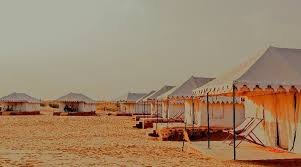The Jaisalmer Fort is undoubtedly the crown jewel of the city, but Jaisalmer’s charm doesn’t end at its sandstone walls. For those willing to step off the tourist path, the real essence of Jaisalmer lives in its hidden temples and quiet, winding lanes. These lesser-known spots reveal stories of devotion, craftsmanship, and community that often go unnoticed.
What Lies Outside the Fort?
While the fort attracts thousands with its grandeur, the lanes outside it carry the daily rhythm of local life. These streets are not just thoroughfares—they are living corridors of history. Walking through them, visitors come across old havelis, community wells, traditional homes, and small shrines that are still used for daily worship.
Every lane in Jaisalmer has its own character. Some are lined with intricate jharokhas and carved doorways. Others open into small squares where children play, women gather, and rituals continue as they have for generations. These are not preserved relics—they are part of living history.
Discovering the Hidden Temples of Jaisalmer
Beyond the popular Jain Temples inside the fort, several lesser-known shrines are scattered across the town. One such temple is the Laxminath Temple, situated on the fort’s outskirts. Unlike the ornate Jain structures, this temple is simpler in design but holds equal significance in the hearts of locals. Dedicated to Vishnu and his consort Laxmi, it plays an essential role during local festivals and rituals.
Another remarkable shrine is the Tanot Mata Temple, though located a bit farther from the city, it remains deeply rooted in Jaisalmer’s spiritual fabric. Locals often speak of miracles associated with this temple during wartime, making it not only a religious site but a place of legend and resilience.
The Surya Mandir (Sun Temple), although smaller and tucked away, is rich in symbolism. Built for sun worship, this temple features carvings and a unique layout that catches the morning light. It’s often missed by tour groups, but for the observant traveler, it offers a peaceful moment and a chance to connect with the region’s spiritual diversity.
What Do the Narrow Lanes Reveal?
Jaisalmer’s narrow lanes are more than a maze—they’re a mirror to its unchanged traditions. Each turn presents something unexpected: a tiny shop selling local spices, a man carving sandstone by hand, a woman painting the doorstep with rangoli, or an elderly priest preparing offerings at a roadside shrine.
These lanes connect neighborhoods like Gopa Chowk, Malka Pol, and Gandhi Chowk—areas where the old still coexists with the new. Travelers often report the joy of wandering these paths without a plan, guided only by curiosity. The farther one drifts from the fort, the closer they get to the town’s real soul.
Local Life and Everyday Rituals
A key part of understanding these lanes is observing how temples blend seamlessly into daily routines. They aren’t just monuments; they’re functional community spaces. In the early morning, one may see women lighting lamps, men chanting prayers, or elders offering flowers. During special occasions, even the smallest temples become vibrant centers of celebration.
The temples are typically maintained by families or community trusts. While some are open all day, others have set timings. Photography might not be allowed in all locations, so it’s best to observe respectfully and seek permission if in doubt.
Cultural Preservation Through Oral Histories
Unlike large historical structures that are recorded and archived, these hidden temples and surrounding lanes survive through oral history. Locals pass down stories from generation to generation—about a temple’s origin, a saint who once visited, or a miracle that took place there.
These stories are vital for understanding the cultural landscape. Speaking with locals—especially elders—can bring these tales to life. Many are happy to share, particularly with those who listen with genuine interest.
When Is the Best Time to Explore?
The most comfortable time to explore Jaisalmer’s narrow streets and temples is during the cooler months, from October to March. Mornings and late afternoons are ideal for walking, as the sun is milder and the streets are more active. While exploring, wearing comfortable footwear and carrying water is advisable due to the uneven pathways and dry climate.
Local guides can help identify hidden spots, but self-guided walks can be just as rewarding. Maps may not always list these temples, so asking shopkeepers or residents for directions often leads to interesting discoveries.
Where to Stay for Easy Exploration?
Staying in a traditional Desert Camp in Jaisalmer offers a different perspective compared to staying within the town. While the camp is situated a bit outside the main city, many travelers prefer it for its peaceful surroundings and access to both sunrise and sunset desert experiences.
By day, one can head into town to explore the temples and lanes; by evening, return to the desert for quiet moments under the stars. This rhythm allows for both cultural immersion and natural retreat in a single trip.
Comfort Meets Culture in the Desert
For those who want a deeper connection with the desert and its heritage, staying in a Luxury Tent in Jaisalmer offers a blend of comfort and cultural experience. These tents are modeled after traditional Rajasthani dwellings but include modern amenities. They offer a chance to rest, reflect, and even read or journal about the day’s discoveries.
In the quiet of the desert, the sounds and sights of the town—temple bells, chants, footsteps on cobbled lanes—become memories that last long after the journey ends.




